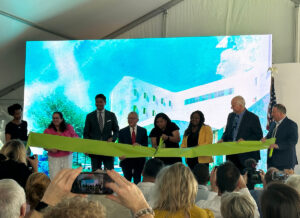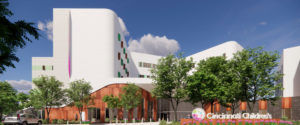A Haven for Hope
Cincinnati Children’s, William K. Schubert M.D. Mental Health Center
←
To All
Cincinnati, OH | 160,000 SF
 Through soft shapes, the play of light, and connection to nature, the new facility acts as a haven of hope.
Through soft shapes, the play of light, and connection to nature, the new facility acts as a haven of hope.
Modern life bombards us with stressors. Coping with them can be particularly hard for children and adolescents, especially those with pre-existing behavioral health issues. When kids and teens need services to help manage a mental illness or life crisis, they need a supportive behavioral health setting.
 A variety of shared spaces, like the gym, create destinations within the building.
A variety of shared spaces, like the gym, create destinations within the building.
 The play of light on walls and floors throughout the day help make the experience of something familiar--walking through a corridor--feel different depending on the time and the season.
The play of light on walls and floors throughout the day help make the experience of something familiar--walking through a corridor--feel different depending on the time and the season.
We worked with Cincinnati Children’s Hospital Medical Center to re-think the collection of therapeutic settings known as milieu. These are the spaces where patients will spend most of their time, participating in group therapy, guided activities, free choice time, and other therapies. The building’s design was influenced by the location and variety of milieu spaces on the units within the building and their role as shared resources and destinations. The design emphasizes meaningful environments that mimic moving through one’s day, like changing classes at school. Patient spaces throughout the interior incorporate positive distractions and allow for different behaviors—such as pacing, rocking, or self-expression; built in benches and nooks allow patients to comfortably occupy a room’s edges. The new building will also feature a Family Resource Center and a café—to allow more opportunities for families to support their child or adolescent during treatment.
Dichroic (color changing) glass fins on the exterior façade and in an oculus in the lobby enhance a feeling of transparency and welcome and invite curiosity, create interest and a sense of something new every visit.
 Milieu spaces like this one allow patients to gather for group therapy or guided activities while providing space for different behaviors, like rocking or pacing.
Milieu spaces like this one allow patients to gather for group therapy or guided activities while providing space for different behaviors, like rocking or pacing.
In addition to outpatient services, private, in-patient rooms are grouped in “sleeping wings” for each unit and can be closed off during the day as patients engage with a variety of therapies.
 In-patient rooms allow for overnight visits from parents and caregivers.
In-patient rooms allow for overnight visits from parents and caregivers.
 Views out provide connection to the landscape and changing seasons.
Views out provide connection to the landscape and changing seasons.
 The new facility is designed to feel transparent, hopeful, and uplifting.
The new facility is designed to feel transparent, hopeful, and uplifting.
Connecting to nature is an important aspect of any healthcare environment. The new building will have a softness to it— materials and forms that evoke a sense of nature, rounded edges, ample sunlight, and views of the landscape are used to encourage visitors to linger and find a haven for hope and healing.
-
News




 An oculus in the lobby provides daylight and a positive distraction thanks to color shifting glass.
An oculus in the lobby provides daylight and a positive distraction thanks to color shifting glass.
 Dichroic glass fins (color changing) create interest (outside and inside) and a sense of something new every visit.
Dichroic glass fins (color changing) create interest (outside and inside) and a sense of something new every visit.
 Places to hug edges help provide a sense of prospect and refuge.
Places to hug edges help provide a sense of prospect and refuge.
 Soft edges and rounded forms help reinforce a sense of comfort and safety.
Soft edges and rounded forms help reinforce a sense of comfort and safety.
 Milieu spaces are flexible and adaptable to suit different activities or group therapies.
Milieu spaces are flexible and adaptable to suit different activities or group therapies.

